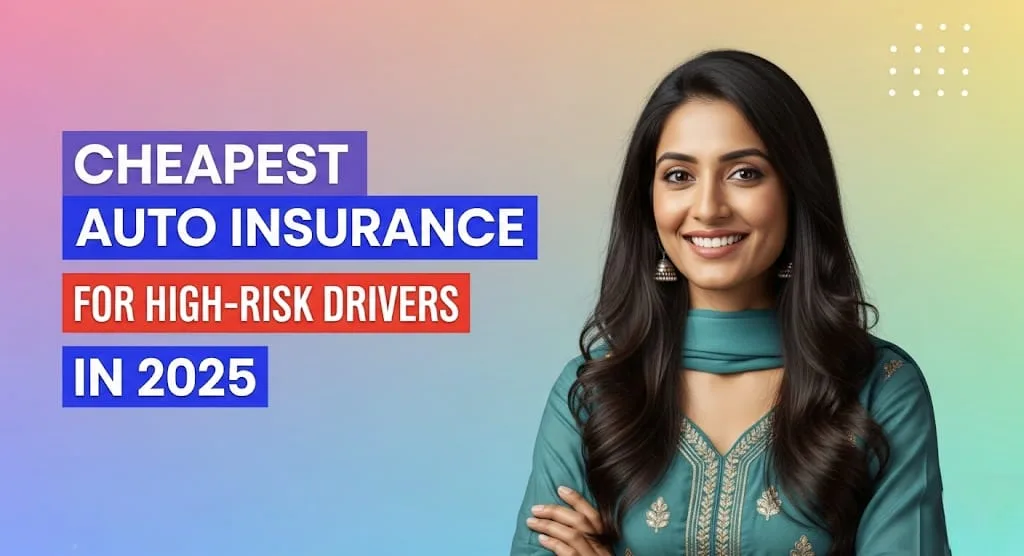Navigating the world of auto insurance can be tricky, but for high-risk drivers, it often feels like an uphill battle. The year 2025 brings with it new trends and considerations in the insurance landscape, making it crucial for those with less-than-perfect driving records to understand their options. This article aims to shed light on how high-risk drivers can still find affordable auto insurance and drive with peace of mind.
Understanding “High-Risk” – Are You One? 🧐
Before diving into solutions, let’s define what typically classifies a driver as “high-risk” in the eyes of insurance companies. It’s not a label anyone desires, but understanding the criteria is the first step toward managing its impact.
- Serious Traffic Violations: This is perhaps the most common factor. Violations like DUI/DWI (Driving Under Influence/Driving While Intoxicated), reckless driving, or multiple speeding tickets within a short period almost certainly land you in the high-risk category.
- Accident History: While a single minor fender-bender might not label you high-risk, multiple at-fault accidents definitely will. Insurance providers see this as a pattern of increased likelihood for future claims.
- Lack of Driving Experience: Young or new drivers often fall into this category due to their limited time on the road, regardless of their driving record. This is especially true for teen drivers.
- No Prior Insurance Coverage: A gap in your insurance history or a lack of continuous coverage can signal instability to insurers, leading to a higher-risk assessment.
- Poor Credit History: In some regions, a low credit score can also influence your insurance premiums, as it’s often seen as an indicator of overall financial responsibility.
Being labeled “high-risk” means insurers perceive a greater chance of you filing a claim, which translates to higher premiums. However, it doesn’t mean affordable coverage is out of reach entirely.
The Landscape of Auto Insurance in 2025 for High-Risk Drivers 🌍
The auto insurance market in 2025 is evolving, with several factors influencing rates, especially for high-risk individuals. Inflation, the increasing cost of vehicle repairs due to advanced technology, and a rise in accident frequency are all contributing to generally higher premiums across the board.
- Technological Advancements in Vehicles: Modern cars are equipped with sophisticated ADAS (Advanced Driver Assistance Systems) like automatic emergency braking and lane-keeping assist. While these enhance safety, their repair costs after an accident are significantly higher, impacting premiums.
- Inflation and Repair Costs: The rising costs of parts and labor in the automotive industry mean that even minor repairs can be expensive. This directly affects how much insurers pay out, which is then reflected in premium rates.
- Usage-Based Insurance (UBI): Telematics devices and mobile apps that monitor driving behavior (speed, braking, mileage) are becoming more prevalent. For high-risk drivers committed to improving their habits, UBI programs could offer a pathway to lower rates by demonstrating responsible driving.
- Regulatory Changes: Government bodies like IRDAI in India are continuously refining regulations to make insurance more accessible and transparent. This includes the push for standardized policies and more flexible options like “pay-as-you-go,” which could benefit careful high-risk drivers.
Despite these challenges, specialized insurance providers and certain strategies can help high-risk drivers find coverage that doesn’t break the bank.
Finding the Cheapest Coverage: Strategies for High-Risk Drivers 🎯
It might seem daunting, but several proven strategies can help high-risk drivers secure more affordable auto insurance in 2025.
- Shop Around Aggressively: This is the most critical step. Do not settle for the first quote. Different insurance companies have varying risk assessment models and appetites for high-risk clients. Comparing multiple quotes from various providers, including those specializing in non-standard insurance, is essential. Online comparison platforms can be incredibly helpful here.
- Focus on Essential Coverage: While comprehensive coverage offers maximum protection, it comes at a higher cost. For high-risk drivers on a tight budget, focusing on the legally mandated third-party liability insurance might be a starting point. However, always weigh the risks of underinsurance.
- Increase Your Deductible: Opting for a higher deductible means you’ll pay more out-of-pocket in case of a claim, but it significantly lowers your monthly premiums. Ensure you have sufficient savings to cover this deductible if an incident occurs.
- Improve Your Driving Record: This is a long-term strategy but the most impactful. Maintaining a clean driving record by avoiding further accidents and violations will eventually lead to lower rates. Consider taking a defensive driving course, as some insurers offer discounts for this.
- Look for Discounts: Even as a high-risk driver, you might qualify for certain discounts. These can include:
- Good student discounts (if applicable)
- Multi-car discounts
- Bundling discounts (combining auto with home insurance)
- Safety feature discounts (for vehicles with anti-theft devices, airbags, etc.)
- Low mileage discounts (if you drive less)
- Consider Pay-as-You-Go/Usage-Based Insurance: As mentioned earlier, UBI programs can be a game-changer. If you consistently drive safely, even with a past record, these programs can reward you with lower premiums based on your actual driving habits.
- Downgrade Your Vehicle: If feasible, driving an older, less expensive car can reduce the cost of collision and comprehensive coverage, as the insured declared value (IDV) is lower.
Insurance Providers to Consider in 2025 for High-Risk Drivers 🤝
While specific recommendations vary by individual circumstances and location, certain insurance companies are known for their willingness to work with high-risk drivers. In India, companies like The General (though more prominent in the US, similar non-standard insurers exist), and others who offer flexible plans might be worth exploring. It’s always best to get quotes from a range of providers, including those that might not be mainstream for standard drivers. Local insurance brokers who specialize in high-risk policies can also be invaluable resources.
🌟 Highlights for High-Risk Auto Insurance in 2025 🌟
| Increased Premiums | Expect higher rates due to inflation & rising repair costs. |
| Usage-Based Insurance (UBI) | Key to potential savings for safe driving habits. |
| Aggressive Shopping Needed | Compare quotes from diverse insurers, including specialists. |
| Clean Record Pays Off | Long-term commitment to safe driving is the ultimate cost-saver. |
The Path to Lower Premiums: A Long-Term Vision 🛣️
For high-risk drivers, obtaining cheapest auto insurance is not a one-time event but a journey. The goal should be to steadily improve your driving profile, which will naturally lead to more favorable rates over time.
- Maintain Continuous Coverage: Avoid any lapses in your insurance policy. Even if it’s the minimum required third-party liability, continuous coverage demonstrates responsibility.
- Practice Defensive Driving: Beyond just avoiding tickets, actively practice defensive driving techniques. This reduces the likelihood of accidents and builds a positive driving record.
- Enroll in Traffic School (if applicable): If offered for minor infractions, completing a traffic school course can sometimes remove points from your license or prevent them from impacting your insurance rates as severely.
- Regularly Review Your Policy: At each renewal, take the time to review your policy. Your circumstances might have changed, or new discounts might have become available.
Conclusion: Driving Towards a Safer, More Affordable Future 🌟
Being a high-risk driver for insurance purposes can feel isolating, but it’s not a permanent sentence to exorbitant premiums. In 2025, with increasing options for usage-based insurance and the continued importance of diligent shopping, high-risk drivers have more tools than ever to find affordable coverage. By understanding the factors that impact rates, actively seeking out competitive quotes, and committing to safer driving habits, you can gradually reduce your insurance costs and ensure you’re protected on the road. Remember, persistence and responsible driving are your greatest allies in securing the cheapest auto insurance possible.
Frequently Asked Questions (FAQs) 🤔
1. How long will I be considered a high-risk driver?
The duration typically depends on the severity of the offense and the insurance company’s policies. Minor violations might impact your record for 3-5 years, while serious offenses like a DUI can affect your rates for 5-10 years or even longer. Consistently maintaining a clean driving record after an incident is key to shedding the “high-risk” label sooner.
2. Can taking a defensive driving course really lower my premium?
Yes, in many cases! Some insurance companies offer discounts for completing approved defensive driving courses. These courses demonstrate your commitment to safe driving and can help offset the perceived risk associated with your past record. It’s always worth checking with your insurer before enrolling.
3. What if no traditional insurance company will cover me?
If traditional insurance providers decline to offer you coverage, you might need to explore non-standard insurance companies that specialize in high-risk policies. In some regions, there are also state-assigned risk pools or residual market plans as a last resort to ensure every driver can obtain the legally required minimum coverage. Consulting with an independent insurance agent who deals with various carriers can be very beneficial in such situations.



